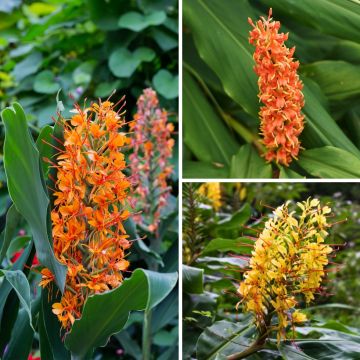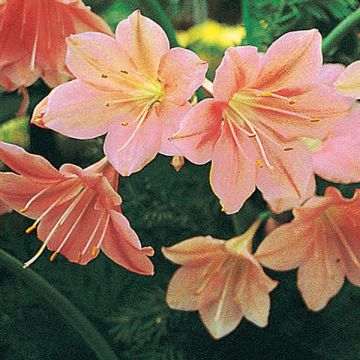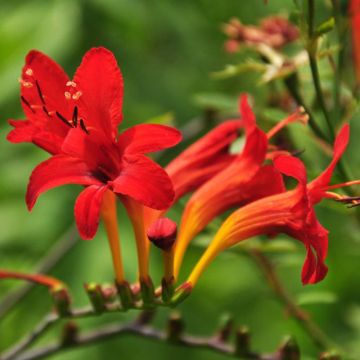

Lilium martagon Duo - Martagon Lily
Lilium martagon Duo - Martagon Lily
Lilium martagon sp,, Album
Martagon Lily, Turk's Cap Lily
Special offer!
Receive a €20 voucher for any order over €90 (excluding delivery costs, credit notes, and plastic-free options)!
1- Add your favorite plants to your cart.
2- Once you have reached €90, confirm your order (you can even choose the delivery date!).
3- As soon as your order is shipped, you will receive an email containing your voucher code, valid for 3 months (90 days).
Your voucher is unique and can only be used once, for any order with a minimum value of €20, excluding delivery costs.
Can be combined with other current offers, non-divisible and non-refundable.
This plant carries a 6 months recovery warranty
More information
We guarantee the quality of our plants for a full growing cycle, and will replace at our expense any plant that fails to recover under normal climatic and planting conditions.
Would this plant suit my garden?
Set up your Plantfit profile →
Collection items (2 plants)
Description
This Duo Martagon Lily, comprising Lilium martagon Rose and Lilium martagon var. Album, brings together two beautiful forms of this iconic botanical lily from the Alps. Their flowers, in the shape of a turban, come in a soft pink with speckles for the Lilium martagon Rose and in immaculate white for the Lilium martagon var. Album. Their flowering, which begins in June, extends over several weeks until August. The foliage of these lilies is deciduous, consisting of lanceolate leaves arranged in whorls along the stem. They have an elegant and graceful habit, with the floral stem reaching up to 1.50 m in height. The flowers, in addition to their colour, are distinguished by their unique shape and slightly curved petals. These plants take a little longer to establish, but the bulbs can withstand fairly low minimum temperatures. Although they tolerate periods of drought, they thrive in cool and well-drained soil.
The duo consists of:
- x 1 Lilium martagon Rose: its delicate pink flowers are speckled with purple. Measuring 5 cm in diameter, they are arranged in airy clusters on sturdy stems. Up to 50 flowers bloom on each tubular stem, which is smooth and slightly purple. The plant can reach a height of 1.50 m when in bloom.
- x 1 Lilium martagon var. album: this lily impresses with its pure and luminous white flowers. Its large flowers, measuring up to 6 cm in diameter, proudly stand on sturdy stems reaching 1.30 m. Its flowering, coinciding with that of its pink counterpart, brings visual complementarity to borders and beds.
Bulbs labeled separately.
Martagon Lilies are ideally planted in autumn to allow them to establish before winter. These plants adapt perfectly to borders, beds, and rockeries, and can also be grown in pots for those with a balcony or terrace. The ideal substrate for these lilies is a rich, cool, and well-drained soil. In the garden, these lilies can be planted together to create a beautiful contrast between the pink and white flowers. Alternate the bulbs of each variety to maximize visual impact. Allow for a spacing of about 20 to 30 cm between each bulb. This allows the plants to fully develop. Plant the bulbs at a depth equivalent to three times their height. This depth ensures good anchoring and protection against winter frosts.
To accompany the Martagon Lily Duo in the garden, choose plants that have similar needs and matching colours. The Astrantia major 'Roma', with its pale pink flowers, forms a magnificent contrast with the lilies and can be planted mixed with them, offering a different texture while extending the flowering period of the bed. The Geranium 'Rozanne', with its blue flowers, adds a touch of fresh color and will be used as an attractive foreground. The Digitalis purpurea 'Alba', known for its tall white flower spikes, is ideally positioned in the background, forming a backdrop that highlights the lily flowers.
Plant habit
Flowering
Foliage
Botanical data
Lilium
martagon
sp,, Album
Liliaceae
Martagon Lily, Turk's Cap Lily
Alps
Planting and care
The Lilium martagon establishes itself with a little more difficultly than Asian, trumpet or Oriental lilies. It may take an additional season before flowering and planting conditions must be carefully considered. Martagon lilies sulk when moved and need time to settle. Perfect drainage must be ensured, a rocky soil is ideal, so that the bulbs are not in overly moist substrate during their dormancy period, after flowering. The bulbs could rot during a cold and rainy winter or spring. It is strongly advised not to add peaty compost, but a supply of well-rotted compost or leaf soil in autumn is desirable. Plant them in full sun or partial shade, preferably in spring, burying the bulbs 15 cm deep in a pouch of soil mixed with leaf soil and gravel. Surround them with a pouch of sand to prevent rot and attacks from slugs. Mark the planting location, as vegetation only starts in April. If red insects appear, treat them immediately, as they are lily beetles whose larvae can devour all the leaves. The most effective method is to catch them manually, but be careful, they drop as soon as you touch them, so put a box underneath. Otherwise, treat regularly with permethrin. After flowering, it is useful to cut the ste,s of the faded flowers halfway to keep the bed beautiful during the summer. Your lilies will be available from early October.
Planting period
Intended location
Care
Planting & care advice
This item has not been reviewed yet - be the first to leave a review about it.
Similar products
Haven't found what you were looking for?
Hardiness is the lowest winter temperature a plant can endure without suffering serious damage or even dying. However, hardiness is affected by location (a sheltered area, such as a patio), protection (winter cover) and soil type (hardiness is improved by well-drained soil).

Photo Sharing Terms & Conditions
In order to encourage gardeners to interact and share their experiences, Promesse de fleurs offers various media enabling content to be uploaded onto its Site - in particular via the ‘Photo sharing’ module.
The User agrees to refrain from:
- Posting any content that is illegal, prejudicial, insulting, racist, inciteful to hatred, revisionist, contrary to public decency, that infringes on privacy or on the privacy rights of third parties, in particular the publicity rights of persons and goods, intellectual property rights, or the right to privacy.
- Submitting content on behalf of a third party;
- Impersonate the identity of a third party and/or publish any personal information about a third party;
In general, the User undertakes to refrain from any unethical behaviour.
All Content (in particular text, comments, files, images, photos, videos, creative works, etc.), which may be subject to property or intellectual property rights, image or other private rights, shall remain the property of the User, subject to the limited rights granted by the terms of the licence granted by Promesse de fleurs as stated below. Users are at liberty to publish or not to publish such Content on the Site, notably via the ‘Photo Sharing’ facility, and accept that this Content shall be made public and freely accessible, notably on the Internet.
Users further acknowledge, undertake to have ,and guarantee that they hold all necessary rights and permissions to publish such material on the Site, in particular with regard to the legislation in force pertaining to any privacy, property, intellectual property, image, or contractual rights, or rights of any other nature. By publishing such Content on the Site, Users acknowledge accepting full liability as publishers of the Content within the meaning of the law, and grant Promesse de fleurs, free of charge, an inclusive, worldwide licence for the said Content for the entire duration of its publication, including all reproduction, representation, up/downloading, displaying, performing, transmission, and storage rights.
Users also grant permission for their name to be linked to the Content and accept that this link may not always be made available.
By engaging in posting material, Users consent to their Content becoming automatically accessible on the Internet, in particular on other sites and/or blogs and/or web pages of the Promesse de fleurs site, including in particular social pages and the Promesse de fleurs catalogue.
Users may secure the removal of entrusted content free of charge by issuing a simple request via our contact form.
The flowering period indicated on our website applies to countries and regions located in USDA zone 8 (France, the United Kingdom, Ireland, the Netherlands, etc.)
It will vary according to where you live:
- In zones 9 to 10 (Italy, Spain, Greece, etc.), flowering will occur about 2 to 4 weeks earlier.
- In zones 6 to 7 (Germany, Poland, Slovenia, and lower mountainous regions), flowering will be delayed by 2 to 3 weeks.
- In zone 5 (Central Europe, Scandinavia), blooming will be delayed by 3 to 5 weeks.
In temperate climates, pruning of spring-flowering shrubs (forsythia, spireas, etc.) should be done just after flowering.
Pruning of summer-flowering shrubs (Indian Lilac, Perovskia, etc.) can be done in winter or spring.
In cold regions as well as with frost-sensitive plants, avoid pruning too early when severe frosts may still occur.
The planting period indicated on our website applies to countries and regions located in USDA zone 8 (France, United Kingdom, Ireland, Netherlands).
It will vary according to where you live:
- In Mediterranean zones (Marseille, Madrid, Milan, etc.), autumn and winter are the best planting periods.
- In continental zones (Strasbourg, Munich, Vienna, etc.), delay planting by 2 to 3 weeks in spring and bring it forward by 2 to 4 weeks in autumn.
- In mountainous regions (the Alps, Pyrenees, Carpathians, etc.), it is best to plant in late spring (May-June) or late summer (August-September).
The harvesting period indicated on our website applies to countries and regions in USDA zone 8 (France, England, Ireland, the Netherlands).
In colder areas (Scandinavia, Poland, Austria...) fruit and vegetable harvests are likely to be delayed by 3-4 weeks.
In warmer areas (Italy, Spain, Greece, etc.), harvesting will probably take place earlier, depending on weather conditions.
The sowing periods indicated on our website apply to countries and regions within USDA Zone 8 (France, UK, Ireland, Netherlands).
In colder areas (Scandinavia, Poland, Austria...), delay any outdoor sowing by 3-4 weeks, or sow under glass.
In warmer climes (Italy, Spain, Greece, etc.), bring outdoor sowing forward by a few weeks.



















































